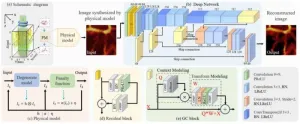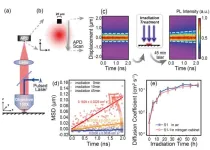(Press-News.org) The persistent higher rate of alcohol deaths in England since the pandemic in 2020 is an “acute crisis” requiring urgent action from government, according to a new study led by researchers at UCL and the University of Sheffield.
For the study, published in Lancet Public Health, researchers analysed Office for National Statistics (ONS) figures of deaths caused solely by alcohol in England. They found that death rates were stable between 2009 and 2019, but increased by a fifth in 2020, rising by a further 13.5% between 2020 and 2022.
The team estimated that 3,911 more people had died solely because of alcohol in England between 2020 and 2022 than would have been the case if pre-pandemic trends had continued.
The largest increases were among groups most likely to be affected before the pandemic – men, people from deprived areas, and those aged 50 to 69. The main cause, the researchers found, was a steep rise in liver damage caused by alcohol. Deaths from acute causes such as alcohol poisoning also increased.
The latest ONS figures from 2023, though not analysed by the new study, show alcohol deaths continuing to rise in England, up to 8,274*.
Lead author Dr Melissa Oldham, of the UCL Institute of Epidemiology & Health Care, said: “The sharp increase in alcohol deaths during the pandemic was no flash in the pan. The higher rate has persisted and is getting worse each year.
“It is an acute crisis, and urgent action is needed to prevent further avoidable deaths. This includes substantial investment in health services to better detect and treat liver disease as well as policies to reduce alcohol consumption in the population as a whole, such as minimum unit pricing and advertising restrictions.”
Senior author Professor Colin Angus, of the University of Sheffield’s School of Medicine and Population Health, said: “The increase in alcohol deaths is entrenching existing health inequalities, with large absolute increases among men and among people from deprived areas. Men, just as before the pandemic, are twice as likely to die because of alcohol compared to women, with almost three times as many additional alcohol-specific deaths in the most deprived areas compared to the least deprived.”
In the paper the researchers said the increase in liver disease deaths may be partly explained by an increase in drinking among heavier drinkers and by more frequent binge drinking, as well as reduced access to health services during the pandemic and reduced treatment seeking. Increases in drinking seen during the pandemic and lockdowns do not seem to have returned to pre-pandemic levels, which could partly explain the continuing increase in alcohol-specific deaths each year.
They said obesity may be a factor, as increased drinking during the pandemic lockdowns may have been accompanied by weight gain and a more sedentary lifestyle, and obesity increases the risk of an alcohol-related liver disease death. Covid-19 may also have had an impact, as having established cirrhosis (scarring of the liver) is linked to a two- to threefold risk of death from a Covid-19 infection, the researchers said.
Co-author Dr Gautam Mehta, of the UCL Division of Medicine, said: “There are marked inequities in the provision of liver care in England. The average age of death from liver disease is nine years lower in the most deprived parts of the country, compared to the least. And, overall, rates of death following a hospital admission with liver cirrhosis are several times higher than comparable admissions for stroke or heart disease. New treatments and strategies for earlier detection are urgently needed.”
Persistent higher alcohol death rates since the pandemic have also been reported in Germany, Estonia, Latvia, Bulgaria, Australia, and the United States.
The researchers added that it was unclear why changes in alcohol consumption at the start of the pandemic had persisted, when for most people day to day life had returned to pre-pandemic routines.
This could be that habits formed during the lockdowns were difficult to break. They suggested that, in England, it could be linked to the cost-of-living crisis, as well as worse mental health, with higher rates of severe psychological distress reported in England between 2020 and 2022.
The study used the ONS definition of alcohol deaths as those registered on the death certificate as having an underlying cause that is wholly attributable to alcohol. This excludes deaths caused partially by alcohol such as alcohol-related cancers or road traffic accidents.
The researchers received funding from the Society for the Study of Addiction, Cancer Research UK and the National Institute for Health Research.
Dr Katherine Severi, Chief Executive, Institute of Alcohol Studies, said: “It’s shocking to see that almost 4,000 more people died in England from alcohol than was expected since the pandemic, with the number continuing to rise.
“We’ve known for years now that changing drinking habits during lockdowns increased levels of alcohol harm – this study underlines the impact that had on worsening health inequalities across England.
“The government has made tackling inequalities one of its health priorities. There is no way of doing that without introducing a comprehensive alcohol strategy that tackles cheap, excessively available, and aggressively marketed alcohol.”
Professor Sir Ian Gilmore, Chair, Alcohol Health Alliance, said: “Five years on from the start of the pandemic, we are still seeing the devastating consequences of increased alcohol consumption. Drinking trends have not returned to pre-pandemic levels, and the latest data confirms that alcohol-specific deaths remain at record highs – hitting those who were already at greatest risk before the pandemic the hardest.
“Alarmingly, the burden of alcohol harm continues to fall disproportionately on the most deprived communities, and it is deepening existing health inequalities. The government must act urgently to introduce evidence-based policies, such as minimum unit pricing, to reduce alcohol harm and save lives.”
END
Increase in alcohol deaths in England an ‘acute crisis’
Peer reviewed / Observational / People
2025-04-10
ELSE PRESS RELEASES FROM THIS DATE:
Government urged to tackle inequality in ‘low-carbon tech’ like solar panels and electric cars
2025-04-10
Decarbonisation in the automotive and housing sectors is paramount if the UK’s legally binding commitment to achieving net zero by 2050 is to succeed, say researchers at University of Sheffield
Exploring the presence of socioeconomic inequalities in the uptake of low-carbon technologies (LCTs), such as solar panels and electric vehicles, has important policy implications for the decarbonisation in the UK
The new report advocates for interventions at an individual, as well as community-level, to help those from more disadvantaged backgrounds adopt technologies that ...
Moffitt-led international study finds new drug delivery system effective against rare eye cancer
2025-04-10
TAMPA, Fla. (Apr. 10, 2025) — A multi-institutional study led by Moffitt Cancer Center found that percutaneous hepatic perfusion using a melphalan hepatic delivery system may help patients with a rare eye cancer that has spread to their liver. This disease, known as metastatic uveal melanoma, is traditionally very hard to treat and usually has poor outcomes.
The phase 3 FOCUS trial, published in the Annals of Surgical Oncology, compared two treatments for metastatic uveal melanoma. One group of patients received the melphalan hepatic delivery system treatment, while the other group received standard of care treatment. Patients treated with the melphalan hepatic delivery ...
Boston stroke neurologist elected new American Academy of Neurology president
2025-04-10
MINNEAPOLIS —The American Academy of Neurology (AAN), the world’s largest association of neurologists and neuroscience professionals, has elected Natalia S. Rost, MD, MPH, FAAN, FAHA, as its 39th president. Rost is professor of neurology at Harvard Medical School in Boston, and the C. Miller Fisher Endowed Chair in Stroke Research and former chief of the stroke division at Massachusetts General Hospital. Rost succeeds Carlayne E. Jackson, MD, FAAN, who completed her two-year term as president during the recent AAN Annual Meeting.
“I applaud Dr. Jackson for her leadership, and I am thrilled to take the helm at the American Academy of Neurology ...
Center for Open Science launches collaborative health research replication initiative
2025-04-10
Charlottesville, VA — The Center for Open Science (COS) has announced the launch of the Replicability Project: Health Behavior (RPHB), a collaborative initiative that aims to strengthen the evidence base and advance scientific integrity in health-related research. The project will examine the replicability of a diverse sample of quantitative health studies published over the past decade (2015–2024).
Assessing the credibility of research is essential to advancing scientific integrity and maintaining public trust in science. The RPHB initiative aims to perform up to 60+ replications of empirical health behavior studies, providing crucial ...
Crystal L. Mackall, MD, FAACR, recognized with the 2025 AACR-Cancer Research Institute Lloyd J. Old Award in Cancer Immunology
2025-04-10
CHICAGO – The American Association for Cancer Research (AACR)-Cancer Research Institute (CRI) Lloyd J. Old Award in Cancer Immunology will be presented to Crystal L. Mackall, MD, Fellow of the AACR Academy, during the AACR Annual Meeting 2025, to be held April 25-30 at the McCormick Place Convention Center in Chicago, Illinois.
Mackall is the Ernest and Amelia Gallo Family Professor and Professor of Pediatrics and Medicine at Stanford University, the founding director of the Stanford Center for Cancer Cell Therapy, and director of the Parker Institute for Cancer Immunotherapy at Stanford. She is being honored for her illustrious contributions to cancer immunotherapy, including ...
A novel strategy for detecting trace-level nanoplastics in aquatic environments: Multi-feature machine learning-enhanced SERS quantification leveraging the coffee ring effect
2025-04-10
A new publication from Opto-Electronic Advances; DOI 10.29026/oea.2025.240260 discusses a novel strategy for detecting trace-level nanoplastics in aquatic environments.
Plastic materials have revolutionized human lifestyles through their versatile applications, yet their environmental legacy now presents critical challenges to global ecosystems and public health. Current models estimate annual plastic influx into aquatic systems at 4.8-12.7 million metric tonnes, with projections suggesting cumulative marine plastic accumulation ...
Blending the old and the new: Phase-change perovskite enable traditional VCSEL to achieve low-threshold, tunable single-mode lasers
2025-04-10
A new publication from Opto-Electronic Advances; DOI 10.29026/oea.2025.240220, discusses how phase-change perovskite enables traditional VCSEL to achieve low-threshold, tunable single-mode lasers.
As an important light source, lasers are widely used in many fields such as communications, medical treatment, display technology and scientific research. However, with the continuous advancement of technology, people have put forward higher requirements on the performance of lasers, especially in terms of integration and tunability. Traditional lasers typically rely on fixed gain media and external microcavity structures (such as Fabry-Perot cavities, ...
Enhanced photoacoustic microscopy with physics-embedded degeneration learning
2025-04-10
A new publication from Opto-Electronic Advances; DOI 10.29026/oea.2025.240189, discusses enhanced photoacoustic microscopy with physics-embedded degeneration learning.
In recent years, photoacoustic imaging (PAI), as an emerging imaging technology, has gradually attracted widespread attention across various fields, particularly in interdisciplinary areas such as medicine, physics, and chemistry. In brief, PAI combines the unique advantages of both optics and acoustics. The fundamental principle of PAI is as follows: when laser light ...
Light boosts exciton transport in organic molecular crystal
2025-04-10
A new publication from Opto-Electronic Advances; 10.29026/oea.2025.240207, discusses how light boosts exciton transport in organic molecular crystal.
Organic semiconductors, composed of organic molecules or polymers, offer advantages such as low cost, flexibility, lightweight design, and tunable structural-functional properties. They have significant applications in OLED displays (e.g., smartphones, TVs), organic photovoltaic cells (flexible solar panels), and flexible sensors. In organic semiconductors, excitons—carriers of excited-state ...
On-chip multi-channel near-far field terahertz vortices with parity breaking and active modulation
2025-04-10
A new publication from Opto-Electronic Advances; DOI 10.29026/oea.2025.240250, discusses on-chip multi-channel near-far field terahertz vortices with parity breaking and active modulation.
Vortex beams with helical phase wavefronts can carry orbital angular momentum (OAM) and have promising applications in high-capacity communication, information processing and high-resolution imaging. With the further development of terahertz (THz) technology in the fields of communication, radar and substance detection, ...
LAST 30 PRESS RELEASES:
Scientists boost cell "powerhouses" to burn more calories
Automatic label checking: The missing step in making reliable medical AI
Low daily alcohol intake linked to 50% heightened mouth cancer risk in India
American Meteorological Society announces Rick Spinrad as 2026 President-Elect
Biomass-based carbon capture spotlighted in newly released global climate webinar recording
Illuminating invisible nano pollutants: advanced bioimaging tracks the full journey of emerging nanoscale contaminants in living systems
How does age affect recovery from spinal cord injury?
Novel AI tool offers prognosis for patients with head and neck cancer
Fathers’ microplastic exposure tied to their children’s metabolic problems
Research validates laboratory model for studying high-grade serous ovarian cancer
SIR 2026 delivers transformative breakthroughs in minimally invasive medicine to improve patient care
Stem Cell Reports most downloaded papers of 2025 highlight the breadth and impact of stem cell research
Oxford-led study estimates NHS spends around 3% of its primary and secondary care budget on the health impacts of heat and cold in England
A researcher’s long quest leads to a smart composite breakthrough
Urban wild bees act as “microbial sensors” of city health.
New study finds where you live affects recovery after a hip fracture
Forecasting the impact of fully automated vehicle adoption on US road traffic injuries
Alcohol-related hospitalizations from 2016 to 2022
Semaglutide and hospitalizations in patients with obesity and established cardiovascular disease
Researchers ‘listen in’ to embryo-mother interactions during implantation using a culture system replicating the womb lining
How changing your diet could help save the world
How to make AI truly scalable and reliable for real-time traffic assignment?
Beyond fragmented markets: A new framework for efficient and stable ride-pooling
Can shape priors make road perception more reliable for autonomous driving?
AI tracks nearly 100 years of aging research, revealing key trends and gaps
Innovative techniques enable Italy’s first imaging of individual trapped atoms
KIER successfully develops Korea-made “calibration thermoelectric module” for measuring thermoelectric device performance
Diversifying US Midwest farming for stability and resilience
Emphasizing immigrants’ deservingness shifts attitudes
Japanese eels, climate change, and river temperature
[Press-News.org] Increase in alcohol deaths in England an ‘acute crisis’Peer reviewed / Observational / People




